Charles Kettles: Vietnam veteran whose service medal was upgraded by President Obama 50 years on
The army helicopter pilot braved a perilous rescue mission four times to get all of his comrades out

The Song Tra Cau riverbed near Duc Pho, South Vietnam, was dubbed “Chump Valley”. Only a chump, American soldiers said, would venture there.
On Monday 15 May 1967 Major Charles Kettles did just that, braving punishing fire from the North Vietnamese to make four helicopter journeys delivering reinforcements to outnumbered members of the 101st Airborne Division – and evacuate the wounded and the dead.
Kettles was credited with saving the lives of 44 men and received the Distinguished Service Cross, the military’s second-highest award for valour, for his actions. Nearly half a century later, the award was upgraded to Medal of Honour.
President Barack Obama, bestowing the medal on Kettles in 2016, recalled a comrade who called Kettles “our John Wayne”.
Kettles, who died aged 89, retired from the army in 1978 at the rank of lieutenant colonel.
Kettles insisted that the medal of honour belonged not to him but to the other men who joined him in the chopper mission. He was their flight commander, an aviation buff since childhood in Michigan experimenting on a Ford Motor Co flight simulator.
He volunteered for the first flight into the river valley, braving an enemy battalion that had the advantage of tunnels and bunkers, as well as a placement on a 1,500ft hill.
Approaching the landing zone, Obama said, Kettles and the other helicopter crews “should have seen a stand of green trees; instead, they saw a solid wall of green enemy tracers coming right at them.” Never, Obama added, had they experienced such heavy fire.
According to an army account of the events, some soldiers arriving with Kettles were killed even before they could disembark. Napalm dropped on the surrounding hills brought little reprieve from the enemy fire. For the return trip, Kettles refused to leave until the helicopters were loaded with as many wounded as they could carry.
On his second trip, his gunner suffered wounds that would result in the amputation of his leg. Kettles flew him and other wounded back to the base, even as their aircraft was leaking fuel.
When the infantry battalion commander requested the evacuation of the 40 men remaining in the valley, Kettles volunteered to go back for them, as well as four more from his unit. He was leading a group of evacuation helicopters away and believed all men to be accounted for when he received a radio communication that eight had been unable to board. He left the formation, going back alone.
At that point, according to the army account, the North Vietnamese “concentrated all firepower on his lone aircraft”. Yet the eight men managed to board his dangerously damaged helicopter. To pick up enough speed for lift-off, Kettles bounced the craft along the ground like a “jack rabbit”, he later recalled.
The Distinguished Service Cross was awarded to Kettles in 1968. Only decades later, when he recounted his experience to an oral historian with the Library of Congress’s Veterans History Project, did momentum build for him to receive the Medal of Honour.
Kettles was born in Ypsilanti, Michigan, in 1930. He was attending what is now Eastern Michigan University when he was drafted into the army in 1951. Having trained as an officer by 1953, he served stints in postwar Korea, Japan and Thailand before returning to Michigan, where he operated a Ford car dealership and served in the army reserve.
He volunteered for active duty in 1963 and served two tours in Vietnam, the first in 1967 and the second in 1969 to 1970. His decorations included the Legion of Merit, the Distinguished Flying Cross, the Bronze Star Medal and multiple awards of the Air Medal and the Army Commendation Medal.
After his military retirement, Kettles received a bachelor’s degree in business management in 1978 from Our Lady of the Lake University in San Antonio and a master’s degree in industrial technology from Eastern Michigan University in 1979. He taught drafting and aviation technology at EMU, also working for Chrysler Pentastar Aviation.
His first marriage, to Ann Theresa Maida, ended in divorce. Survivors include Ann, his wife of 41 years, and six children from his first marriage.
Charles Seymour Kettles, soldier, born 9 January 1930, died 21 January 2019
© Washington Post
Subscribe to Independent Premium to bookmark this article
Want to bookmark your favourite articles and stories to read or reference later? Start your Independent Premium subscription today.

Join our commenting forum
Join thought-provoking conversations, follow other Independent readers and see their replies